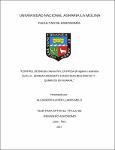Mostrar el registro sencillo del ítem
Control de Botrytis cinerea Pers. en fresa (Fragaria x ananassa Duch.) cv. Aromas mediante fungicidas biológicos y químicos en Huaral
| dc.contributor.advisor | Apaza Tapia, Walter Eduardo | |
| dc.contributor.author | Llanos Melo, Alejandro Kleper | |
| dc.date.accessioned | 2017-12-27T16:04:12Z | |
| dc.date.available | 2017-12-27T16:04:12Z | |
| dc.date.issued | 2017 | |
| dc.identifier.other | H20.L44-T BAN UNALM | |
| dc.identifier.uri | https://hdl.handle.net/20.500.12996/3018 | |
| dc.description | Universidad Nacional Agraria La Molina. Facultad de Agronomía. Departamento Académico de Fitopatología | es_PE |
| dc.description.abstract | El moho gris causado por BotrytiscinereaPers. es una de las enfermedades más importantes en el cultivo de la fresa. Debido a su alta variabilidad genética y sus características patogénicas, el uso adecuado de fungicidas es crucial para el manejo de esta enfermedad. Por ello, el objetivo del presente trabajo fue evaluar el efecto de cinco fungicidas químicos; Tryfloxistrobin (0.0625%), Pirimetanil + Fluopyram (0.1%), Pirimetanil (0.1%), Fenhexamid (0.75 l/ha) y Carbendazim (0.125%), y dos biológico; BacillussubtilisCepa QST713 (0.75%) y BacilluspumilusCepa QST2808 (0.75%). La fase de laboratorio (UNALM) se realizó evaluando el efecto en la inhibición micelial midiendo el diámetro de crecimiento a 4DDI. Adicionalmente, se evaluó la inhibición en la germinación de conidios de dos maneras. Primero, en agua estéril más el fungicida a través del conteo de cien conidios a las 24 HDI. Segundo, en medio PDA envenado contando el número de UFC a los 3 DDI. Las dosis de 1x106 y 125 conidios/ml fueron usados para cada ensayo respectivamente. El aislamiento utilizado fue extraído del área donde se realizó la fase de campo (Huaral-Aucallama). En esta segunda fase los fungicidas químicos fueron aplicados cada dos semanas mientras que los fungicidas biológicos semanalmente. Se realizaron 12 cosechas evaluando el peso y el número total de los frutos de primera, segunda e infectados con Botrytis. Así también, se colectó semanalmente flores de fresa del área de ensayo y fueron puestas en cámara húmeda para evaluar la incidencia de BC. Los resultados demostraron que los fungicidas químicos; Tryfloxystrobin, Pirimetanil + Fluopyram, Pirimetanil, Fenhexamid y el fungicida biológico BacillussubtilisCepa QST713 presentaron considerable actividad contra Botrytiscinereaen la mayoría de los ensayos realizados tanto a nivel in vitro como en condiciones de campo. | es_PE |
| dc.description.abstract | The gray mold, caused by Botrytis cinereaPers., is one of the most important plant diseases in Strawberry. Due to its high variability and its pathogenic characteristics, the proper fungicides use is crucial to control this disease. Thus, the aim of this study was to evaluate the effect of five chemical fungicides; Tryfloxistrobin (0.0625%), Pyrimethanil + Fluopyram (0.1%), Pyrimethanil (0.1%), Fenhexamid (0.75 l/ha) y Carbendazim (0.125%), and two biological; Bacillus subtilis Cepa QST713 (0.75%) y Bacillus pumilusCepa QST2808 (0.75%). In the laboratory phase (UNALM), the inhibition of mycelial growth was measured by evaluating diameter growth at 4DDI. Furthermore, conidial germination inhibition was evaluated in two different ways. First, one hundred conidia were evaluated in sterile water with fungicide at 24 HDI. Second, the number of CFUs were counted in poisoned PDA medium at 3 DDI. The doses 1x106 and 125 conidia/ml were used for each test respectively. The fungus was isolated from the area where the field phase was carried out (Huaral-Aucallama). In this second phase, chemical fungicides were sprayed every other week, while biological fungicides were sprayed weekly. Twelve harvests were done. The total weight and total number of the first, second category, and infected fruits were evaluated. Moreover, Strawberry flowers were collected weekly from the experimental área. Then, they were placed in a humid chamber to evaluate BC incidence. The results showed that chemical fungicides; Trifloxystrobin, Pyrimethanil + Fluopyram, Pyrimethanil, Fenhexamid and the biological fungicide Bacillus subtilis QST713 had considerable activity against Botrytis cinereain most of the in vitro trials and field conditions. | en_US |
| dc.format | application/pdf | en_US |
| dc.language.iso | spa | es_PE |
| dc.publisher | Universidad Nacional Agraria La Molina | es_PE |
| dc.rights | info:eu-repo/semantics/openAccess | en_US |
| dc.rights.uri | https://creativecommons.org/licenses/by-nc-nd/4.0/ | * |
| dc.subject | Fragaria ananassa | es_PE |
| dc.subject | Variedades | es_PE |
| dc.subject | Botrytiscinerea | es_PE |
| dc.subject | Enfermedades fungosas | es_PE |
| dc.subject | Fungicidas | es_PE |
| dc.subject | Lucha integrada | es_PE |
| dc.subject | Control de enfermedades | es_PE |
| dc.subject | Experimentación en campo | es_PE |
| dc.subject | Experimentación en laboratorio | es_PE |
| dc.subject | Evaluación | es_PE |
| dc.subject | Perú | es_PE |
| dc.subject | Fresa aromas | es_PE |
| dc.subject | Moho gris | es_PE |
| dc.subject | Auca llama (Dist.) | es_PE |
| dc.subject | Huaral (prov.) | es_PE |
| dc.subject | Región Lima | es_PE |
| dc.title | Control de Botrytis cinerea Pers. en fresa (Fragaria x ananassa Duch.) cv. Aromas mediante fungicidas biológicos y químicos en Huaral | es_PE |
| dc.type | info:eu-repo/semantics/bachelorThesis | en_US |
| thesis.degree.discipline | Agronomía | es_PE |
| thesis.degree.grantor | Universidad Nacional Agraria La Molina. Facultad de Agronomía | es_PE |
| thesis.degree.name | Ingeniero Agrónomo | es_PE |
| dc.subject.ocde | http://purl.org/pe-repo/ocde/ford#4.01.07 | es_PE |
| renati.author.dni | 44722455 | es_PE |
| dc.publisher.country | PE | es_PE |
| dc.type.version | info:eu-repo/semantics/publishedVersion | en_US |
| renati.advisor.orcid | https://orcid.org/0000-0001-7510-8866 | es_PE |
| renati.advisor.dni | 10474225 | es_PE |
| renati.type | https://purl.org/pe-repo/renati/type#tesis | es_PE |
| renati.level | https://purl.org/pe-repo/renati/level#tituloProfesional | es_PE |
| renati.discipline | 811036 | es_PE |
| renati.juror | Casas Díaz, Andrés Virgilio | |
| renati.juror | Cadenas Giraldo, Carlos Alberto | |
| renati.juror | Aragón Caballero, Liliana Maria |
Ficheros en el ítem
Este ítem aparece en la(s) siguiente(s) colección(ones)
-
AGR-FP Tesis [60]




